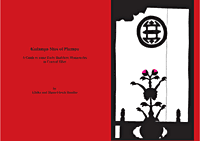
This beautifully produced landscape format book, released by the up-and-coming Vajra Publications, is an important contribution to our understanding of the Kadampa school of Buddhism. The two authors, an academic and an architect, take obvious delight in the topic and transmit this infectious pleasure through the book.
Ulrike and Hans-Ulrich Roesler modestly refer to their Kadampa Sites of Phempo as a 'booklet' and a 'survey', but in truth their contribution is much greater. In the summers of 2000 and 2002, they travelled to Phempo, 30 km north of Lhasa, in search of early monasteries. Not only did they find many monasteries and document them but the authors were surprised to learn that in other modern guidebooks, 'information about their present condition is scarce'. Their book, dedicated to the 'people of Phempo, past and present', is an attempt to put Phempo on the map.
The Kadampa school has played a central role in the history of Buddhism, as well as its spread through Tibet. This tradition, later absorbed by the Gelukpa school, was based on the teachings of the Indian master Atisha, whose disciple was thought to be the founder of Kadampa practice in the early 11th century. The monastic foundations laid by the Kadampas certainly helped strengthen Buddhist learning in Central Tibet, and Kadampa teaching focussed on practice rather than on philosophy and scholarship. According to the Roeslers, Kadampa masters stressed 'a solid, step by step Buddhist practice, ideally by leading a secluded life concentrated on learning' (p 7).
On their tour, the authors were intrigued to learn that all of the centres of Kadampa learning, except for the monastery at Phuchung, are to this day inhabited by monks or nuns who focus on their spiritual practice. The architectural sketches and photos presented in this book illustrate that by the 11th and 12th centuries, the Phempo region was home to a great number of monasteries with a thriving and vibrant religious culture.
After an informative introduction, the main text of the book describes in brief a series of religious sites. Concise written overviews of monasteries alternate with colour plates (some of the reproductions are a little over-saturated), giving a sense of the history as well as the present condition of the site. The appendices to the survey deserve special mention. The catalogue, or register, of Shara Gompa is presented in full, including a photo of the Tibetan text, its transliteration and translation. The final appendix, with which the book concludes, is comprised of well-drawn architectural plans of Nesur monastery based on measurements taken in 2002.  I have only two quibbles with this otherwise delightful book, one practical and the other commercial. For those readers not schooled in written Tibetan, like myself, it would have been interesting to have the meanings of the place names and monasteries spelt out clearly in the glossary at the end of the book. My other question relates to marketing: it never becomes apparent who the intended audience is. Not detailed enough to satisfy scholars and a little unwieldy for casual tourists eager to minimise the load of their backpacks. I fear that the charming Kadampa Sites of Phempo may fall in between categories and have a restricted readership.
I have only two quibbles with this otherwise delightful book, one practical and the other commercial. For those readers not schooled in written Tibetan, like myself, it would have been interesting to have the meanings of the place names and monasteries spelt out clearly in the glossary at the end of the book. My other question relates to marketing: it never becomes apparent who the intended audience is. Not detailed enough to satisfy scholars and a little unwieldy for casual tourists eager to minimise the load of their backpacks. I fear that the charming Kadampa Sites of Phempo may fall in between categories and have a restricted readership.
The joy in its creation is perhaps enough for the authors, however, who write: 'the extremely interesting and most pleasant experience of visiting these places instilled the desire in us to record in this booklet what we witnessed' (Preface).
Mark Turin is a linguistic anthropologist and Director of the Digital Himalaya Project http://www.digitalhimalaya.com


